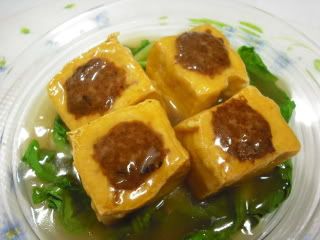
Ok, ok, maybe not a hundred, but my family's
Pancit Bihon recipe has a lot of ingredients which makes it soooo good and so special. Pancit Bihon is one of the wonderful Chinese dishes that have become Filipino. It's a staple in birthday parties and even special occasions in the office. They say that the long noodles means long life for the birthday celebrant or long success for the business.
In my family, it's a wonderful afternoon snack that my mom and my brother fix for the whole family. The noodles used are called "bihon" (hence the name) which are thin rick stick noodles. The ingredients can be as sparse as just onions, cabbage and green beans or as lavish as containing pork, chicken, chinese sausage, etc. It can be adapted as a vegetarian dish or can be a "clean-out-your-veggie-bin" dish.
Anyway, let me teach you the basics on how to do this wonderfully tasty noodle snack.
Pancit Bihon1 package rice noodles (bihon), sometimes it would say makes 1 kilo
2 cups chicken or pork broth (a must, don't substitute water)
2 tablespoon cooking oil
1 tablespoon minced garlic
1/2 onion, thinly julienned (sliced into long, thin strips
1/2 carrots, thinly julienned
1 green bell pepper, thinly julienned
1 cup green beans, thinly julienned (beginning to get the idea?)
2 cups of cabbage, thinly shredded
1 cup cooked chicken meat, flaked
1 cup cooked pork, thinly julienned (this must have fat on it, trust me)
1 chinese sausage, thinly julienned
1/4 cup dark soy sauce
salt & pepper
1. The preparation for this dish is time consuming, thinly slicing almost everything and boiling the meat (chicken & pork). But once you get everything prepared, it takes about 20-30 minutes to cook everything in a large wok. In a large basin, soak the rice noodles in warm water for about 5 minutes. Drain and set aside.
2. Heat the oil in the wok, when hot dump the minced garlic. Stirfry for about half a minute until light golden brown. Add the sliced onions next. Again, stirfry for a minute until the onions are translucent.
3. Do this technique for the following veggies: carrots, green beans and then bell pepper. After everything is stirfried in the wok. Add the cooked meat and sausage. Stir-fry for a minute
4. Add the chicken broth to the wok. Let it come to a simmer, add the drained rice noodles. With two spatulas (or chopsticks if you prefer) start mixing the noodles and the ingredients in the wok. Continue doing this until the noodles are throughtly mixed with the veggies.
5. Add the soy sauce and the cabbage. Again, mix and stir everything up. Let the noodles cook until all the broth is absorbed by the noodles and the color is uniform all over. Salt and pepper as desired. This would take 5-7 minutes.
6. Serve hot with
Puto (Filipino rice cake) or garlic toast on the side. Add a half of calamansi fruit to individual plates so that it can be squeezed over the noodles. If you don't have calamansi, add lemon wedges instead.
Enjoy your Pancit Bihon!

















































